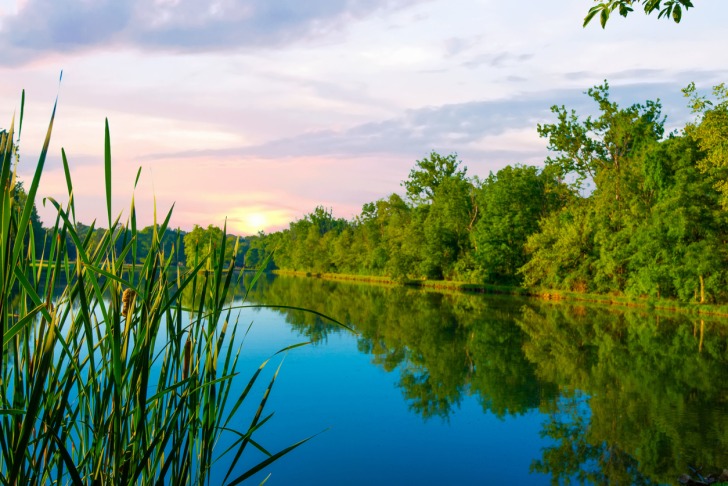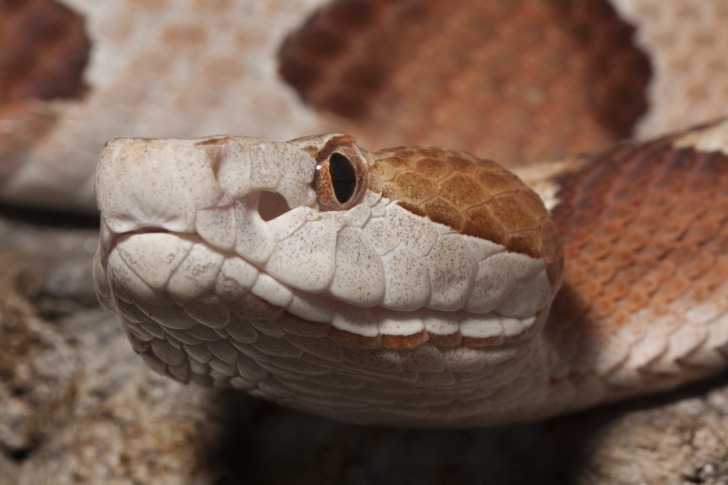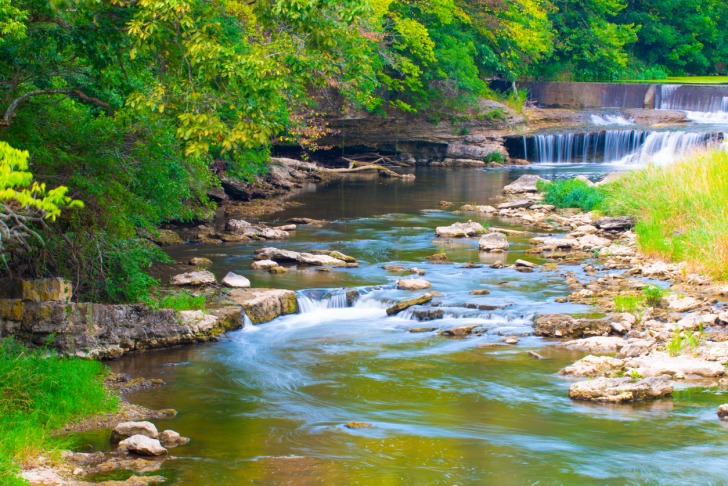Indiana is home to many species of snakes, including four species of venomous snakes.
People have heard myths, legends, and real-life accounts of encounters with snakes that date back several generations.
Does Indiana have monstrous snakes?
What happened to Big Jim?
Learning about Indiana’s snakes, their habits, and tips to enjoy nature can help keep people safe.

Contents
So… Are There Snakes in Indiana?
The World Population Review ranks Indiana at number 17 on their list of states with the highest number of snake species.
Some physical characteristics of Indiana’s snakes include that they have an elongated body covered in scales, and have specialized scales, called scutes, on their belly.
They do not have ear openings.
Snakes hear some sounds through vibrations in their jaw bones.
They hibernate between late fall and early spring.
The Indiana Department of Natural Resources indicates that there are 32 native species of snakes in Indiana.
Four of the 32 species are venomous snakes.
Snake Species in Indiana
Common Indiana Snakes
The Eastern garter snake is the most common native Indiana snake.
It is non-venomous and can be found throughout the state.
It has three light-colored stripes running the entire length of its body.
The snake grows up to a little over two feet long.
Common garter snakes tolerate cold weather more than some other snakes.
They live around grassy wetlands, near streams or ponds.
Garter snakes eat mice, earthworms, and amphibians.
The ribbon snake, a relative of the garter snake, has a dark, slender body.
The three stripes on its body are usually yellow, although the middle stripe may be orange or green.
Ribbon snakes stay close to marshes and streams, where they eat fish and frogs.
Racer snakes live throughout Indiana.
The blue racer is found in the northern to central part of the state.
The black racer lives in central to southern Indiana.
Blue racers are deep gray or blue, with a darker head.
Black racers are satiny black and gray.
Racers move quickly, feeding on other snakes, frogs, insects, birds, and lizards.
Black rat snakes live throughout Indiana, except for the far northwest corner.
They are light gray to black with smooth scales.
The belly of this snake is white or with a checkerboard black and white pattern, which distinguishes it from the black racer.
Farmers often welcome the black rat snake because it eats mice.
The snake lives in barns and outbuildings.
The midland brown snake lives throughout Indiana.
It is often mistaken for a garter snake.
The snake has two rows of black spots down the length of its body.
It lives in moist wooded areas and marshes.
Venomous Indiana Snakes
Indiana has four species of venomous snakes.
The western cottonmouth snake grows up to five feet long.
It can be found in southwestern Indiana, in wetlands areas.
The snake has a large triangular head, with coloring that ranges from tan to black.
Timber rattlesnakes are the largest venomous snake in Indiana.
They have a heavy body, ranging from yellow to almost black, with a black chevron pattern.
The snake adds a new rattle segment each time it sheds its skin.
Eastern Massasauga rattlesnakes live in northern Indiana.
They grow up to 30 inches long and are gray to brown.
These snakes have a heavy body, a broad, triangular head, and dark blotches on their backs.
They are also known as the “swamp rattler.”
Northern copperheads are two to three feet long and live in southern Indiana.
They range from light gray to reddish-brown and have hourglass-shaped bands.
The most common venomous snake lives in dry, rocky areas or barns.

Is It Safe to Go on a Trek in Indiana?
Most of Indiana’s snakes are harmless to people.
They mostly react to being disturbed, whether by accident or on purpose.
The Indiana Department of Natural Resources explains that snakes are misunderstood and that they are important to many ecosystems.
Going on a trek anywhere in Indiana is safe, but take precautions.
Knowing the dangers posed by snakes, as well as other dangers, is important for people hiking, biking, climbing, walking, or swimming in Indiana.
You probably face greater danger from falls, other injuries, or other animals, compared to the dangers posed by most snakes.
Interesting Snake Facts in Indiana
Do not think that the prairie kingsnake is having a seizure when it makes twitchy motions.
It is non-venomous but twitches as a defensive action.
Red scarlet snakes are burrowing snakes that have not been seen since the mid-1900s.
The search efforts for this colorful snake have so far been unsuccessful.
The red milk snake and the eastern milk snake get their names from the myth that they drink cow’s milk.
The myth started because they mostly lived in barns.
Milk snakes lay in wait at night to catch their prey.
They coil around mice and suffocate them before eating them.
Black kingsnakes are secretive snakes that hide under debris, logs, or boards.
They live along the banks of streams and in meadows and have a reputation for killing and eating venomous snakes.
Most snakes have six rows of teeth.
There are two rows of teeth on the top, two rows on the bottom, and two rows on the roof of a snake’s mouth.
Northern ringneck snakes hide behind logs and rotting bark while awaiting the opportunity to eat slugs or earthworms.
It also feasts on lizards and salamanders.
The snake will let you know that it does not appreciate getting caught by people.
It releases a foul-smelling liquid that is a combination of urine, feces, and musk.
The myths and legends of Indiana’s snakes include the story of Big Jim.
The man was working, sending logs down the river with his partners.
Heavy rain started, so the men started a campfire.
Big Jim went to get more wood for the fire.
The other men heard a loud splash in the water and a single scream.
Daylight came, but the men found no sign of the man.
They did find hundreds of large rattlesnakes along the riverbank.
No one ever saw Big Jim again.
3 Safety Tips for Exploring Nature in Indiana
- Leave Indiana’s snakes alone and they will probably leave you alone. Snakes want to be left alone. People who comply with their wishes are less likely to become victims of snake bites.
- Watch where you step. Trek carefully in areas that are known to have snakes. Watch where you step to avoid stepping on a snake and having the Indiana snake take defensive action.
- Practice safety if you encounter a snake. Freeze and calmly back away. Do not run. Keep at least five feet between you and the snake.
Summary
Indiana has 32 snakes, but only four are venomous snakes.
Snakes are found throughout Indiana, although some species live in certain parts of the state.
Leave Indiana’s snakes alone and they will probably leave you alone.
People and snakes can bask in the natural beauty of Indiana.
Indiana Safety Overview
READ THE FULL REPORT: Indiana Safety Review
Safety Index:
- OVERALL RISK: MEDIUM
- TRANSPORT & TAXIS RISK: LOW
- PICKPOCKETS RISK: LOW
- NATURAL DISASTERS RISK: LOW
- MUGGING RISK: MEDIUM
- TERRORISM RISK: MEDIUM
- SCAMS RISK: LOW
- WOMEN TRAVELERS RISK: MEDIUM
Frequently Asked Questions
How often are people bitten by venomous snakes in Indiana?
The Indiana Department of Natural Resources explains that it is rare for people to be bitten by venomous snakes.
What are some other Indiana snake species?
Some other snakes native to Indiana include the copperbelly water snake, the queen snake, and the southeastern crowned snake.
What is the most snake-infested Indiana river?
The most snake-infested river in Indiana is the Wabash River.
The Ohio River and Tippecanoe River are other snake-infested rivers.











